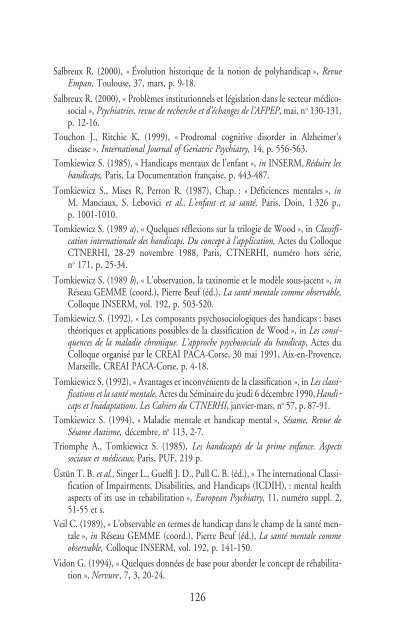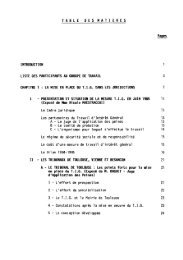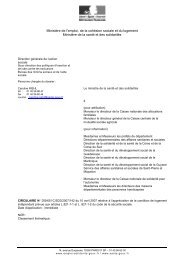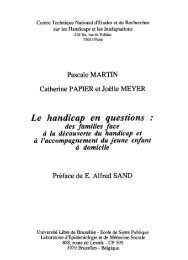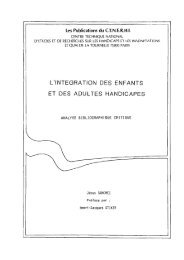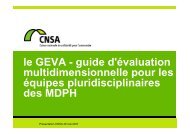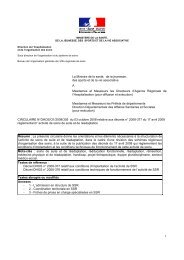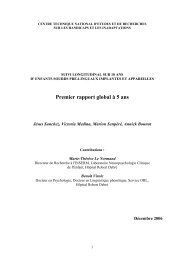classification internationale des handicaps et santé mentale - ctnerhi
classification internationale des handicaps et santé mentale - ctnerhi
classification internationale des handicaps et santé mentale - ctnerhi
Create successful ePaper yourself
Turn your PDF publications into a flip-book with our unique Google optimized e-Paper software.
Salbreux R. (2000), « Évolution historique de la notion de polyhandicap », Revue<br />
Empan, Toulouse, 37, mars, p. 9-18.<br />
Salbreux R. (2000), « Problèmes institutionnels <strong>et</strong> législation dans le secteur médicosocial<br />
», Psychiatries, revue de recherche <strong>et</strong> d’échanges de l’AFPEP, mai, n o 130-131,<br />
p. 12-16.<br />
Touchon J., Ritchie K. (1999), « Prodromal cognitive disorder in Alzheimer’s<br />
disease », International Journal of Geriatric Psychiatry, 14, p. 556-563.<br />
Tomkiewicz S. (1985), « Handicaps mentaux de l’enfant », in INSERM, Réduire les<br />
<strong>handicaps</strong>, Paris, La Documentation française, p. 443-487.<br />
Tomkiewicz S., Mises R, Perron R. (1987), Chap. : « Déficiences <strong>mentale</strong>s », in<br />
M. Manciaux, S. Lebovici <strong>et</strong> al., L’enfant <strong>et</strong> sa santé, Paris, Doin, 1 326 p.,<br />
p. 1001-1010.<br />
Tomkiewicz S. (1989 a), « Quelques réflexions sur la trilogie de Wood », in Classification<br />
<strong>internationale</strong> <strong>des</strong> <strong>handicaps</strong>. Du concept à l’application, Actes du Colloque<br />
CTNERHI, 28-29 novembre 1988, Paris, CTNERHI, numéro hors série,<br />
n o 171, p. 25-34.<br />
Tomkiewicz S. (1989 b), « L’observation, la taxinomie <strong>et</strong> le modèle sous-jacent », in<br />
Réseau GEMME (coord.), Pierre Beuf (éd.), La santé <strong>mentale</strong> comme observable,<br />
Colloque INSERM, vol. 192, p. 503-520.<br />
Tomkiewicz S. (1992), « Les composants psychosociologiques <strong>des</strong> <strong>handicaps</strong> : bases<br />
théoriques <strong>et</strong> applications possibles de la <strong>classification</strong> de Wood », in Les conséquences<br />
de la maladie chronique. L’approche psychosociale du handicap, Actes du<br />
Colloque organisé par le CREAI PACA-Corse, 30 mai 1991, Aix-en-Provence,<br />
Marseille, CREAI PACA-Corse, p. 4-18.<br />
Tomkiewicz S. (1992), « Avantages <strong>et</strong> inconvénients de la <strong>classification</strong> », in Les <strong>classification</strong>s<br />
<strong>et</strong> la santé <strong>mentale</strong>, Actes du Séminaire du jeudi 6 décembre 1990,Handicaps<br />
<strong>et</strong> Inadaptations. Les Cahiers du CTNERHI, janvier-mars, n o 57, p. 87-91.<br />
Tomkiewicz S. (1994), « Maladie <strong>mentale</strong> <strong>et</strong> handicap mental », Sésame, Revue de<br />
Sésame Autisme, décembre, n o 113, 2-7.<br />
Triomphe A., Tomkiewicz S. (1985), Les handicapés de la prime enfance. Aspects<br />
sociaux <strong>et</strong> médicaux, Paris, PUF, 219 p.<br />
Üstün T. B. <strong>et</strong> al., Singer L., Guelfi J. D., Pull C. B. (éd.), « The international Classification<br />
of Impairments, Disabilities, and Handicaps (ICDIH), : mental health<br />
aspects of its use in rehabilitation », European Psychiatry, 11, numéro suppl. 2,<br />
51-55 <strong>et</strong> s.<br />
Veil C. (1989), « L’observable en termes de handicap dans le champ de la santé <strong>mentale</strong><br />
», in Réseau GEMME (coord.), Pierre Beuf (éd.), La santé <strong>mentale</strong> comme<br />
observable, Colloque INSERM, vol. 192, p. 141-150.<br />
Vidon G. (1994), « Quelques données de base pour aborder le concept de réhabilitation<br />
», Nervure, 7, 3, 20-24.<br />
126


